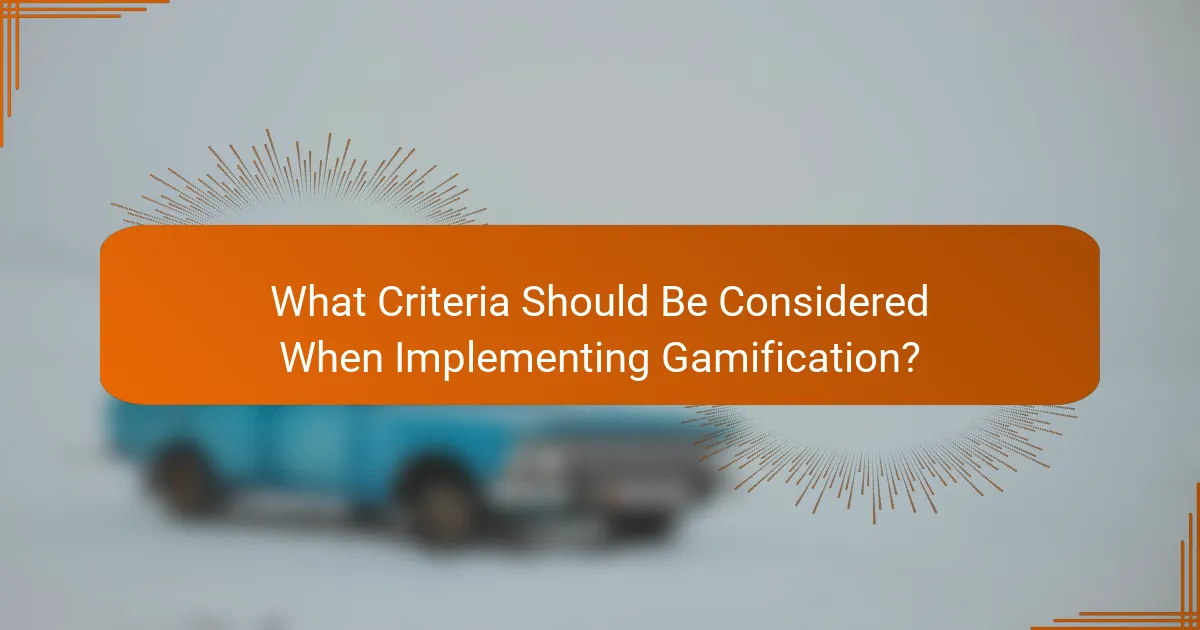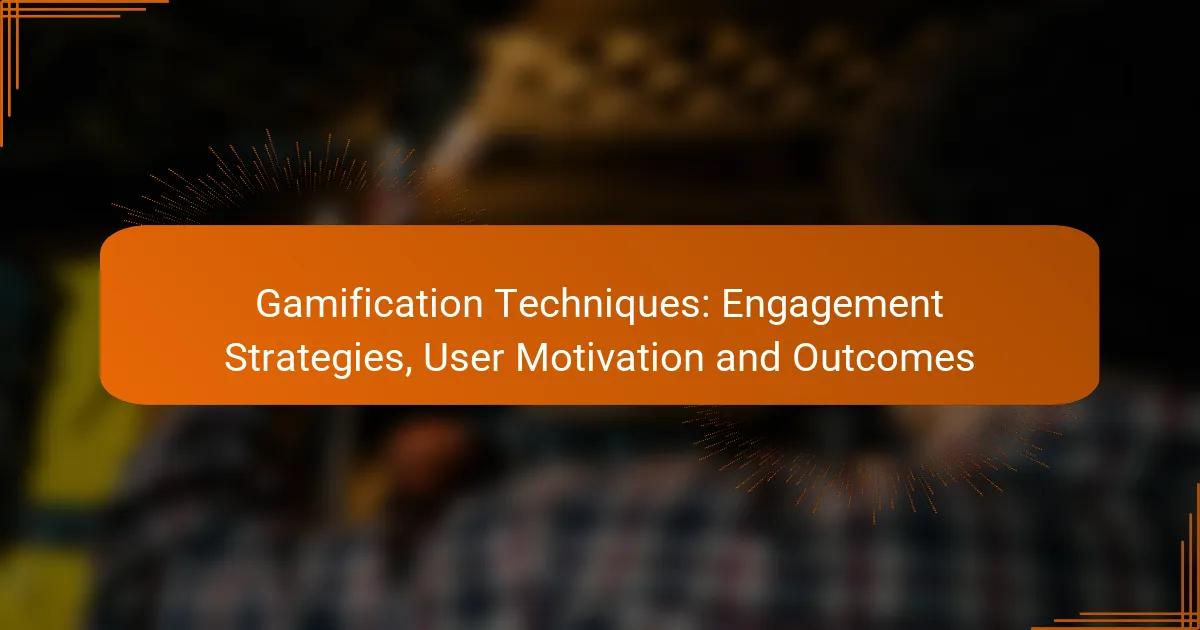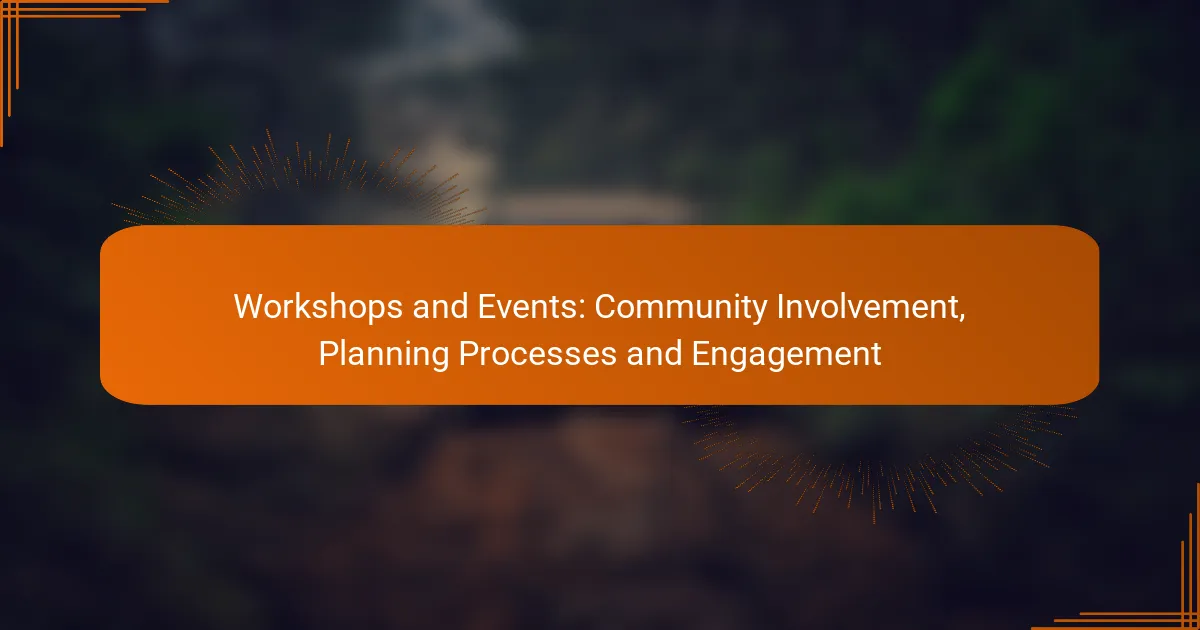Gamification techniques leverage game-like elements to boost user engagement in non-game contexts, transforming mundane tasks into interactive experiences. By incorporating rewards, competition, and progress tracking, these strategies significantly enhance user motivation, leading to increased participation and improved outcomes. Ultimately, effective gamification can result in measurable benefits such as higher retention rates and better conversion rates.

What Are Effective Gamification Techniques for Engagement?
Effective gamification techniques enhance user engagement by incorporating game-like elements into non-game contexts. These strategies motivate users to participate more actively and achieve desired outcomes through rewards, competition, and progress tracking.
Points and Rewards Systems
Points and rewards systems incentivize user participation by assigning points for specific actions, which can later be exchanged for rewards. This method encourages users to engage consistently, as they see tangible benefits from their efforts.
To implement a successful points system, consider setting clear criteria for earning points and ensuring that rewards are desirable and attainable. For example, users might earn points for completing tasks, sharing content, or participating in discussions.
Leaderboards
Leaderboards create a competitive environment by displaying user rankings based on their points or achievements. This visibility can motivate users to improve their performance to climb the ranks.
When using leaderboards, ensure they are updated regularly to maintain user interest. Consider segmenting leaderboards by time frames (daily, weekly, or monthly) to keep competition fresh and encourage more users to participate.
Challenges and Quests
Challenges and quests engage users by providing specific tasks or missions that they can complete for rewards. These activities can vary in difficulty and duration, appealing to a wide range of users.
Design challenges that align with user interests and skill levels to maximize participation. For instance, a fitness app might offer daily challenges like walking a certain number of steps or completing a workout, rewarding users upon completion.
Progress Tracking
Progress tracking allows users to visualize their achievements over time, fostering a sense of accomplishment. This technique can be implemented through progress bars, checklists, or achievement badges.
To enhance effectiveness, provide users with regular updates on their progress and highlight milestones. For example, a language learning app might show users how many lessons they have completed and how close they are to reaching their next level.
Feedback Mechanisms
Feedback mechanisms provide users with immediate responses to their actions, reinforcing positive behaviors and guiding improvements. This can include notifications, scores, or personalized messages based on user performance.
Ensure that feedback is constructive and timely to encourage continued engagement. For example, after completing a task, a user might receive a congratulatory message along with tips for future improvement, enhancing their overall experience.

How Do Gamification Techniques Enhance User Motivation?
Gamification techniques enhance user motivation by integrating game-like elements into non-game contexts, making tasks more engaging and rewarding. These techniques can lead to increased participation, improved learning outcomes, and higher retention rates among users.
Increased Intrinsic Motivation
Intrinsic motivation refers to engaging in an activity for its own sake, driven by personal satisfaction. Gamification fosters this by incorporating elements such as challenges, achievements, and feedback, which can make tasks feel more meaningful. For example, earning badges for completing tasks can create a sense of accomplishment that motivates users to continue participating.
To effectively boost intrinsic motivation, consider setting clear goals and providing immediate feedback. This helps users see their progress and reinforces their desire to engage further. Avoid overly complex systems that may confuse users or detract from their experience.
Enhanced User Experience
Gamification can significantly enhance user experience by making interactions more enjoyable and interactive. By incorporating storytelling, visual elements, and rewards, users are more likely to remain engaged with the content or platform. For instance, a learning app that uses game mechanics can transform mundane lessons into exciting quests.
To improve user experience, focus on intuitive design and seamless integration of gamification elements. Ensure that the gamified features complement the core functionality rather than overwhelm users. Regularly gather user feedback to refine these elements and maintain engagement.
Social Interaction and Competition
Social interaction and competition are powerful motivators in gamification, as they tap into users’ desire for connection and recognition. Features like leaderboards and team challenges encourage users to compete against one another, fostering a sense of community and shared goals. This can lead to increased motivation and sustained engagement over time.
To leverage social aspects effectively, create opportunities for collaboration as well as competition. Encourage users to share their achievements and progress with peers, which can amplify motivation. However, be mindful of the potential for negative competition; ensure that the environment remains supportive and inclusive for all participants.

What Are the Measurable Outcomes of Gamification?
Measurable outcomes of gamification include enhanced user retention, increased engagement, and improved conversion rates. These outcomes reflect how effectively gamification strategies motivate users and drive desired behaviors.
Improved User Retention Rates
Gamification can significantly boost user retention rates by making experiences more enjoyable and rewarding. By incorporating elements like points, badges, and leaderboards, users are more likely to return to platforms that offer these engaging features.
For instance, a mobile app that rewards users with points for daily logins can see retention rates increase by 20-30%. To maximize retention, ensure that rewards are meaningful and that users can easily track their progress.
Higher Engagement Levels
Higher engagement levels are a direct result of gamification techniques that create interactive and immersive experiences. Users are more likely to participate actively when they feel a sense of achievement and competition.
Examples include quizzes that offer rewards for correct answers or challenges that encourage users to complete tasks. To enhance engagement, consider using time-limited challenges that create urgency and excitement.
Increased Conversion Rates
Gamification can lead to increased conversion rates by guiding users through the decision-making process in a fun and engaging way. When users feel rewarded for their actions, they are more likely to complete purchases or sign up for services.
For example, e-commerce sites that implement gamified elements, such as spin-the-wheel discounts or loyalty points, can see conversion rates rise by 10-15%. Focus on creating a seamless experience where gamification complements the purchasing process without overwhelming users.

What Criteria Should Be Considered When Implementing Gamification?
When implementing gamification, it is essential to consider the target audience, set clear objectives, and ensure technology compatibility. These criteria help tailor the gamification strategy to effectively engage users and achieve desired outcomes.
Target Audience Analysis
Understanding the target audience is crucial for successful gamification. Analyze demographics, preferences, and behaviors to create experiences that resonate with users. For example, younger audiences may prefer competitive elements, while older users might value collaborative features.
Utilize surveys or focus groups to gather insights about user motivations and interests. This information can guide the design of gamified elements that enhance engagement and satisfaction.
Clear Objectives and Goals
Establishing clear objectives and goals is vital for measuring the success of gamification efforts. Define what you want to achieve, such as increasing user participation, improving learning outcomes, or boosting sales. Specific, measurable goals help track progress and adjust strategies as needed.
For instance, if the goal is to increase user engagement by 30% within six months, set up metrics to monitor participation rates and user feedback regularly. This approach allows for timely adjustments to the gamification strategy.
Technology and Platform Compatibility
Ensuring that gamification elements are compatible with existing technology and platforms is essential for seamless integration. Assess the technical requirements of gamified features and verify that they work across devices and operating systems commonly used by your audience.
Consider the user experience on mobile devices, as many users access content via smartphones or tablets. Testing gamified elements on various platforms can help identify potential issues and enhance user satisfaction.

What Are Some Successful Examples of Gamification in Marketing?
Successful examples of gamification in marketing leverage game-like elements to enhance user engagement and drive customer loyalty. Brands often use points, badges, challenges, and leaderboards to motivate users and create a more interactive experience.
Starbucks Rewards Program
The Starbucks Rewards program exemplifies effective gamification by allowing customers to earn stars for every purchase, which can be redeemed for free drinks and food. This system not only incentivizes repeat purchases but also fosters a sense of community among members.
Customers can achieve different tiers within the program, unlocking additional benefits as they accumulate stars. This tiered approach encourages users to engage more frequently to reach higher levels, enhancing their overall experience.
Dunkin’ Donuts DD Perks
Dunkin’ Donuts employs gamification through its DD Perks program, where customers earn points for every dollar spent. After reaching a certain number of points, users receive a free beverage, motivating them to choose Dunkin’ over competitors.
The program also features bonus point challenges, encouraging users to visit during specific times or purchase particular items. This strategy not only increases sales but also keeps customers engaged with the brand.
The Nike+ Run Club app integrates gamification by allowing users to track their runs, set goals, and compete with friends. Users earn achievements for milestones, such as distance or frequency, which fosters motivation and a sense of accomplishment.
Additionally, the app offers challenges and virtual races, creating a community atmosphere. This social aspect encourages users to stay active and engaged with the brand while promoting a healthy lifestyle.
Duolingo Language Learning
Duolingo uses gamification to make language learning fun and engaging. Users earn points for completing lessons, can track their progress on a leaderboard, and receive rewards for streaks of consecutive days studying.
This approach not only motivates learners but also creates a competitive environment that encourages consistent practice. The use of levels and badges helps users visualize their achievements and progress, enhancing their learning experience.



